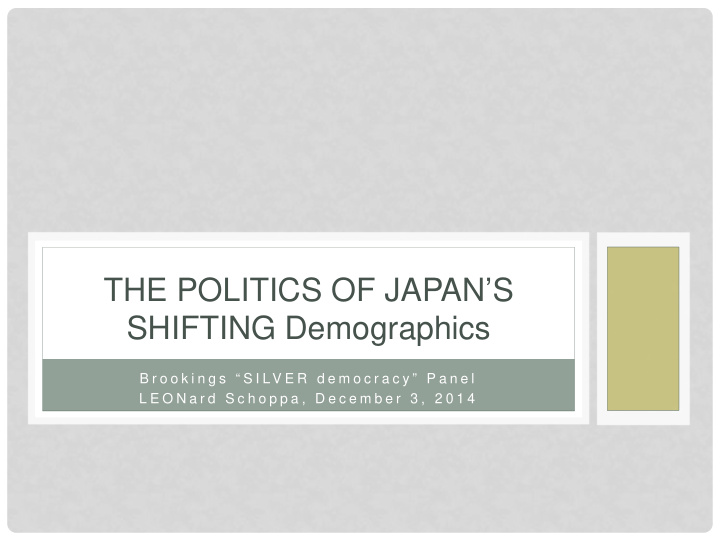



THE POLITICS OF JAPAN’S SHIFTING Demographics B r o o k i n g s “ S I LV E R d e m o c r a c y ” P a n e l L E O N a r d S c h o p p a , D e c e m b e r 3 , 2 0 1 4
DECLINING FERTILITY AND FALLING POPULATION Population Projected to Lose Fewer and Fewer Babies 41 Million by 2060 2,500 140,000 2,000 120,000 Population (in thousands) Births (in thousands) 100,000 1,500 80,000 1,000 60,000 40,000 500 20,000 0 - 1972 1977 1982 1987 1992 1997 2002 2007 2012 2017 2022 2027 2032 2037 2042 2047 2052 2057 1972 1977 1982 1987 1992 1997 2002 2007 2012 2017 2022 2027 2032 2037 2042 2047 2052 2057 Source: data before 2010 from Japan Statistical Yearbook; Figures for 2011-2060 from NIPSSR 2012 Projection
THE SLOW PACE OF IMMIGRATION INTO JAPAN: NET-INFLOW OF JUST 36,000 IN 2011 400 300 200 122 118 115 110 107 housa nds 95 94 80 100 I n-Flo ws into Ja pa n 44 35 36 Out-F lo ws fro m Ja pa n In T Ne t Mig ra tio n 0 2001 2002 2003 2004 2005 2006 2007 2008 2009 2010 2011 -100 -200 -300 Source: OECD Migration Data
SHIFTS IN AGE COMPOSITION OF POPULATION 140,000 Population (in thousands) 120,000 Over 75 100,000 65-74 80,000 60,000 20-64 40,000 20,000 0-19 0 1975 1980 1985 1990 1995 2000 2005 2010 2015 2020 2025 2030 2035 2040 2045 2050 2055 2060
SHIFTS IN AGE COMPOSITION OF ELIGIBLE VOTERS 100% 11% 13% 18% 25% 32% 36% 39% 44% 45% 90% 89% 87% 80% 82% 75% 70% 68% 64% 60% 61% 56% 55% 50% 40% 30% Sha re 65+ 20% Sha re 20-64 10% 0% 1975 1985 1995 2005 2015 2025 2035 2045 2055 Source: data before 2010 from Japan Statistical Yearbook; Figures for 2011-2060 from NIPSSR 2012 Projection
TURNOUT RATES BY AGE IN 2012 LOWER HOUSE ELECTION 90.0% 77.2% 80.0% 76.5% 73.2% 71.0% 70.0% 66.7% 69.3% 62.5% 60.0% 52.6% 55.2% 50.0% 48.1% 47.1% 40.0% 40.3% 35.3% 30.0% 20.0% 10.0% 0.0% 20-24 25-29 30-34 35-39 40-44 45-49 50-54 55-59 60-64 65-69 70-74 75-79 80+ Source: Soumushou Senkyobu, Dai-46-kai Shuugiin Giin Sousenkyo ni okeru Nenrei-betsu Chousa Gaiyou, February 2013.
ELIGIBLE AND ACTUAL VOTERS IN 2012 LOWER HOUSE ELECTION 100% 90% 29.7% 33.2% 80% 70% 60% 65+ 50% 20-64 40% 70.3% 66.8% 30% 20% 10% 0% E lig ib le Vo te rs Ac tua l Vo te rs Source: Soumushou Senkyobu, Dai-46-kai Shuugiin Giin Sousenkyo ni okeru Nenrei-betsu Chousa Gaiyou, February 2013.
PROJECTED SHARE OF ACTUAL VOTERS 100% 90% 37.0% 80% 39.9% 43.0% 48.1% 49.3% 70% 60% 65+ 50% 20-64 40% 63.0% 30% 60.1% 57.0% 51.9% 50.7% 20% 10% 0% (2015) (2025) (2035) (2045) (2055) Applies 2012 age-specific turnout rates to population projected in 2012 NIPPSR population projections.
POSSIBLE POLICY IMPLICATIONS • Older voters may block efforts (via consumption tax increases) to shift tax burden onto the elderly and off of working-age adults and corporations. • They may block efforts to cut pension & medical benefits for the elderly. • On the other hand, they have an incentive in keeping the government solvent enough to pay their retirement benefits.
CONSUMPTION TAX • No da a nd DPJ pa id a hug e pric e in 2012 fo r ra ising the ta x. • Ab e ha s do ne the po litic a lly po pula r thing a nd po stpo ne d the se c o nd-sta g e o f the ta x inc re a se until 2017 a he a d o f this e le c tio n. • Will the pa rty in po we r b e a b le to withsta nd the pre ssure to po stpo ne a g a in?
WORKING AGE JAPANESE ALREADY BEARING A HEAVY LOAD UNDER PENSION REFORM OF 2004 Japanese Employee Pension Japanese National Pension Contribution Rates Contribution Rates (% of salary) (yen/month) 20 18000 16900 18.30 18 16000 16.77 13260 16 14000 13.58 14 12000 12 10000 10 8000 8 6000 6 4000 4 2000 2 0 0 2003 2004 2005 2006 2007 2008 2009 2010 2011 2012 2013 2014 2015 2016 2017 2018 2019 2020 2021 2022 2023 2024 2003 2004 2005 2006 2007 2008 2009 2010 2011 2012 2013 2014 2015 2016 2017 2018 2019 2020 2021 2022 2023 2024
If Japan Can’t Raise Taxes or cut Retiree benefits, its debt problem will get even worse… 250 Public Debt as Japan % of GDP 200 150 United States 100 50 0 2012 2013 2014 1992 1993 1994 1995 1996 1997 1998 1999 2000 2001 2002 2003 2004 2005 2006 2007 2008 2009 2010 2011 OECD Economic Outlook No. 92
AGING VOTERS AND L.D.P. DOMINANCE • Very difficult to speculate about this given how the party system remains in flux. • Today, the LDP benefits from disproportionate support from elderly voters while younger voters have tended to be more supportive of opposition parties. • Possible the LDP will lose support as its most supportive cohorts pass away. But if young cohorts become more conservative as they age, they may sustain the party’s support well into the future….
ELECTION ON DECEMBER 14
Recommend
More recommend